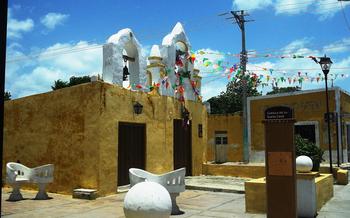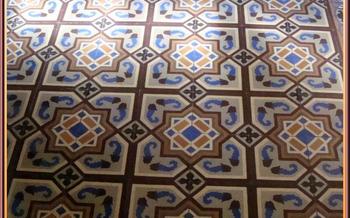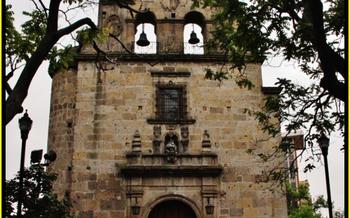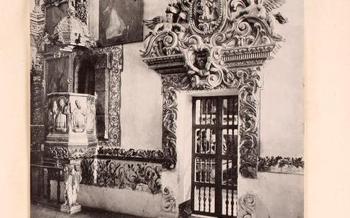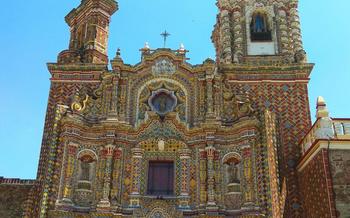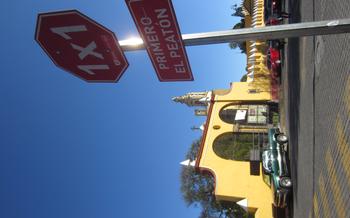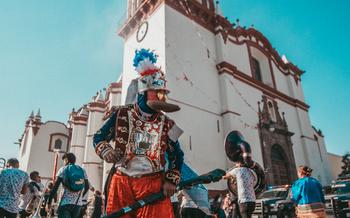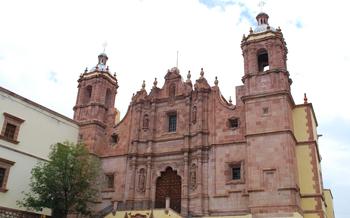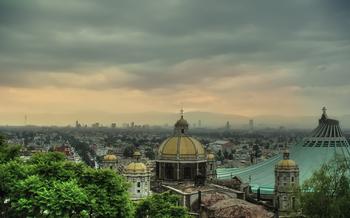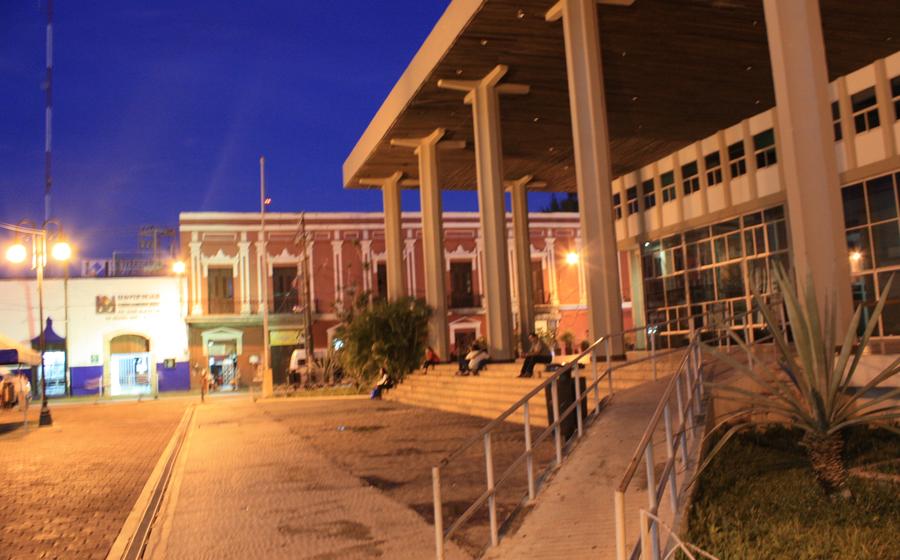
Templo de la Inmaculada Concepción
- The Altarpieces: A Symphony of Sacred Art
- The Murals: Windows to a Divine Realm
- The Stained Glass Windows: A Kaleidoscope of Divine Light
- The Vaulted Ceilings: Reaching for the Heavens
- The Chapel of the Holy Sacrament: A Sanctuary of Reverence
- The Courtyard: A Peaceful Oasis Amidst Bustling Merida
- The Bell Tower: A Call to Worship
- The Crypts: A Silent Testimony to History
- The Festivals and Celebrations: A Vibrant Display of Faith
- The Community: A Living Legacy of Faith
- The Pilgrimages: A Journey of Faith and Devotion
- Insider Tip: Discovering Hidden Gems
The Altarpieces: A Symphony of Sacred Art
The Templo de la Inmaculada Concepción is an artistic treasure trove, and its altarpieces are undoubtedly the most dazzling gems. These stunning works of art are testaments to the exquisite craftsmanship and artistry of the colonial era. Each altarpiece is a unique masterpiece, intricately carved and adorned with gold leaf, polychrome paint, and delicate sculptures.
The symbolism and iconography depicted in the altarpieces are profound and awe-inspiring. They tell stories of biblical events, the lives of saints, and the mysteries of faith. The central altarpiece, dedicated to the Immaculate Conception, is a masterpiece of Baroque art. It features a radiant depiction of the Virgin Mary, surrounded by angels and cherubs. The intricate details and lifelike expressions of the figures are simply breathtaking.
Legends and stories abound about the creation of these altarpieces. Some say that they were crafted by skilled artisans who worked tirelessly for years, guided by divine inspiration. Others whisper of miraculous interventions, where the hands of angels seemed to guide the chisel and brush.
Conservation efforts are meticulously undertaken to preserve these priceless artworks for generations to come. Experts carefully clean, restore, and maintain the altarpieces, ensuring that their beauty and significance endure.
The Murals: Windows to a Divine Realm
The Templo de la Inmaculada Concepción is adorned with a series of stunning murals that transport visitors to a realm of celestial beauty. These awe-inspiring artworks, created by talented local artists, depict biblical scenes and stories with intricate detail and vibrant colors. The murals serve as a testament to the deep faith and devotion of the Merida community, offering a visual narrative of the sacred history of Christianity.
The artistic style of the murals is a blend of traditional Mexican and European influences, resulting in a unique and captivating aesthetic. The artists used a variety of techniques, including fresco, tempera, and oil painting, to create these masterpieces. The murals cover the walls of the church's interior, forming a continuous tapestry of sacred imagery that surrounds the faithful as they worship and pray.
The biblical scenes depicted in the murals range from the Creation of the World to the Crucifixion and Resurrection of Jesus Christ. Each scene is a testament to the artists' skill and devotion, as they meticulously captured the emotions and drama of these pivotal moments. The murals also feature allegorical representations of virtues, such as faith, hope, and charity, reminding visitors of the importance of living a righteous life.
Beyond their artistic value, the murals hold deep symbolic and hidden meanings. They contain references to local history, culture, and traditions, inviting viewers to contemplate the interconnectedness of the divine and the earthly realms. The murals serve as a powerful reminder of the enduring power of faith and the transformative nature of spirituality.
The Stained Glass Windows: A Kaleidoscope of Divine Light
The Templo de la Inmaculada Concepción is adorned with stunning stained glass windows that are a testament to the artistry and craftsmanship of the colonial era. Each window is a unique masterpiece, meticulously crafted using vibrant colors and intricate designs. The windows depict scenes from the Bible, the lives of saints, and other religious figures, creating a kaleidoscope of divine light that fills the interior of the church.
The techniques used to create the stained glass windows are a marvel of craftsmanship. The artisans used a combination of painting and firing to achieve the desired colors and effects. The windows are composed of multiple pieces of glass, each carefully cut and fitted together to form a cohesive image. The result is a breathtaking display of color and light that transforms the church into a sacred space.
The stories and themes depicted in the stained glass windows are a source of inspiration and contemplation for visitors. The windows illustrate scenes from the life of Jesus Christ, the Virgin Mary, and various saints, providing a visual narrative of the Christian faith. The windows also feature allegorical representations of virtues, such as charity, hope, and faith, inviting viewers to reflect on their own spiritual journey.
The natural light that filters through the stained glass windows creates a magical and ethereal atmosphere within the church. As the sun moves throughout the day, the light changes and dances, casting colorful hues onto the walls and floors. This play of light enhances the beauty of the windows and adds to the sense of awe and wonder that visitors experience when they enter the Templo de la Inmaculada Concepción.
The Vaulted Ceilings: Reaching for the Heavens
The Templo de la Inmaculada Concepción's vaulted ceilings are a testament to the architectural prowess of the colonial era. These majestic structures soar high above the nave, creating a sense of awe and inspiration within the church. The ceilings are adorned with intricate designs, delicate moldings, and vibrant frescoes that depict scenes from the Bible and the lives of saints.
The artistry and craftsmanship displayed in the vaulted ceilings are simply breathtaking. The intricate details and vibrant colors create a visual feast that captivates the eye and transports the viewer to a higher realm. The ceilings serve as a reminder of the divine presence that permeates the church and the enduring faith of the people of Merida.
Beyond their aesthetic beauty, the vaulted ceilings hold significant religious and symbolic meaning. They represent the heavens, the dwelling place of God, and the aspiration of the faithful to reach for the divine. The upward sweep of the arches and the intricate patterns create a sense of movement and transcendence, inviting the faithful to contemplate the mysteries of faith and the promise of eternal life.
The vaulted ceilings of the Templo de la Inmaculada Concepción are a masterpiece of colonial architecture and a testament to the enduring faith of the people of Merida. They are a must-see for anyone visiting the city, offering a glimpse into the rich history, culture, and spirituality of this vibrant region.
The Chapel of the Holy Sacrament: A Sanctuary of Reverence
Within unfolds—the Chapel of the Holy Sacrament. Dedicated to the veneration of the Eucharist, this chapel exudes an atmosphere of profound reverence and tranquility. Its architectural design, adorned with intricate carvings, elegant columns, and a breathtaking altar, creates a space conducive to prayer and contemplation.
- History and Significance:
The Chapel of the Holy Sacrament holds a significant place in the history of the Templo de la Inmaculada Concepción. It was constructed in the early 18th century as a testament to the devotion of the faithful to the Blessed Sacrament. Over the centuries, it has served as a spiritual refuge for countless worshippers seeking solace, guidance, and a deeper connection with the divine.
- Architectural Features and Design:
The chapel's architectural features reflect the grandeur and artistry of the colonial era. Its domed ceiling, supported by graceful columns, creates a sense of spaciousness and awe. The altar, a masterpiece of craftsmanship, showcases intricate carvings depicting scenes from the life of Christ. Stained glass windows, casting hues of radiant light, add to the chapel's ethereal atmosphere.
- Rituals and Ceremonies:
The Chapel of the Holy Sacrament is the setting for various religious rituals and ceremonies throughout the year. The most solemn of these is the Mass, where the faithful gather to celebrate the Eucharist and receive Holy Communion. Other ceremonies, such as baptisms, weddings, and confirmations, are also held within its sacred walls, marking important milestones in the lives of the faithful.
- Spiritual Atmosphere and Reverence:
Stepping into the Chapel of the Holy Sacrament is like entering a realm of serenity and devotion. The hushed whispers of prayers, the flickering of candles, and the soft glow of the stained glass windows create an atmosphere conducive to spiritual reflection and contemplation. The chapel invites visitors to pause, seek solace, and find solace in the presence of the divine.
The Courtyard: A Peaceful Oasis Amidst Bustling Merida
Amidst the bustling streets of Merida, the courtyard of the Templo de la Inmaculada Concepción offers a tranquil oasis of serenity and beauty. Surrounded by elegant arches and lush greenery, this hidden gem invites visitors to pause and reflect in its peaceful embrace. The courtyard, with its serene atmosphere, stands in stark contrast to the vibrant energy of the city that surrounds it.
The courtyard's architectural features are a testament to the skill and artistry of the church's builders. Intricate stone carvings, delicate columns, and a graceful fountain create a harmonious ensemble that is both visually appealing and spiritually uplifting. The open space of the courtyard allows for natural light to flood in, casting soft shadows and illuminating the intricate details of the surrounding architecture.
In the courtyard, visitors can find respite from the hustle and bustle of daily life. The gentle sound of water trickling from the fountain and the sweet melodies of birdsong create a tranquil ambiance that encourages contemplation and reflection. Whether seeking a moment of solitude or a peaceful retreat, the courtyard offers a sanctuary for the soul.
The courtyard also plays a significant role in the daily life of the church. It serves as a gathering place for parishioners, who come together for religious ceremonies, community events, and social gatherings. The courtyard's versatility allows it to accommodate a variety of activities, from traditional processions and festivals to concerts and exhibitions.
For those seeking a moment of tranquility amidst the vibrant energy of Merida, the courtyard of the Templo de la Inmaculada Concepción is a hidden gem that offers a peaceful oasis of beauty and serenity. Step into this sacred space and allow the tranquility of the courtyard to wash away the stresses of everyday life, leaving you feeling refreshed and spiritually renewed.
The Bell Tower: A Call to Worship
Standing tall and proud adjacent to the Templo de la Inmaculada Concepción, the bell tower is a prominent landmark visible from various points in Merida. Its construction dates back to the 16th century, serving as a beacon of faith and a symbol of the city's rich religious heritage.
The bell tower's architectural style is a blend of Gothic and Renaissance elements, showcasing intricate carvings and elaborate moldings. Its sturdy structure has withstood the test of time, enduring storms and earthquakes that have ravaged the city over the centuries.
The melodious chimes of the bells echoing through the cobblestone streets of Merida signal the hours of the day and summon the faithful to prayer. The bells are rung by hand, a tradition passed down through generations of bell-ringers, ensuring the continuation of this ancient practice.
Ascending the winding staircase to the top of the bell tower is a rewarding experience. The panoramic views from the observation deck are breathtaking, offering a bird's-eye perspective of the city's colonial architecture, the sprawling plazas, and the lush greenery beyond.
The bell tower of the Templo de la Inmaculada Concepción stands as a testament to the enduring spirit of Merida. Its majestic presence, coupled with the harmonious sound of its bells, creates a captivating symphony that resonates through the heart of the city, inviting visitors to explore the rich history and spiritual significance of this magnificent edifice.
The Crypts: A Silent Testimony to History
Beneath the grand Templo de la Inmaculada Concepción lies a hidden world—the crypts. These subterranean chambers, steeped in history and mystery, offer a glimpse into the past and the lives of Merida's ancestors. Constructed in the 18th century, the crypts served as the final resting place for prominent figures, wealthy families, and members of the clergy.
Descending into the crypts is like stepping back in time. The air is cool and damp, and the walls are lined with niches, each housing a stone sarcophagus. Some of the sarcophagi are adorned with intricate carvings and inscriptions, revealing the names and life stories of the individuals interred within.
Among the notable individuals buried in the crypts are governors, mayors, and religious leaders who played a significant role in shaping Merida's history. Their remains lie in eternal repose, surrounded by the echoes of their accomplishments and contributions to the city.
The crypts are not merely a repository for the dead but also a testament to the city's rich cultural heritage. The architectural features and design of the crypts, with their vaulted ceilings and arched niches, showcase the skill and artistry of Merida's stonemasons and builders.
Visiting the crypts is an opportunity to connect with the past and gain insights into the lives of those who came before us. It is a reminder of the transience of life and the enduring legacy of those who have left their mark on the city of Merida.
The Festivals and Celebrations: A Vibrant Display of Faith
The Templo de la Inmaculada Concepción comes alive during its annual festivals and celebrations, showcasing the vibrant religious traditions of Merida.
The most notable event is the Feast of the Immaculate Conception, held on December 8th. This grand celebration features solemn masses, colorful processions, and traditional dances performed by local groups. Devotees from across the region gather to pay homage to the patron saint of the church and participate in the festivities.
Other important celebrations include Semana Santa (Holy Week), Corpus Christi, and All Saints' Day, each marked by unique rituals and customs. These festivals are not only a display of faith but also a time for the community to come together, share traditions, and strengthen their spiritual bonds.
Attending these festivals is an immersive experience that allows visitors to witness the deep devotion and cultural heritage of the people of Merida.
The Community: A Living Legacy of Faith
The Templo de la Inmaculada Concepción is an integral part of the local community, serving as a spiritual and cultural hub for the people of Merida. Throughout the year, the church hosts a variety of community events and gatherings that bring people together and foster a sense of unity and belonging. These events include religious processions, traditional dances, concerts, and festivals that celebrate the rich cultural heritage of the region.
Beyond its spiritual significance, the church also plays an important role in social and charitable initiatives within the community. The church operates soup kitchens and shelters for the homeless, provides educational programs for children and adults, and supports various healthcare and social welfare initiatives. Through these efforts, the Templo de la Inmaculada Concepción demonstrates its commitment to the well-being and upliftment of the local community.
The church serves as a symbol of unity and spirituality for the people of Merida, transcending religious affiliations and bringing people together in a shared sense of purpose and faith. It is a place where individuals can find solace, seek guidance, and connect with their community, fostering a deep sense of belonging and spiritual connection among the people of Merida.
The Pilgrimages: A Journey of Faith and Devotion
The Templo de la Inmaculada Concepción holds a special significance as a pilgrimage site for devout Catholics from across the region. Each year, thousands of pilgrims flock to the church to pay homage to the Virgin Mary and to seek her blessings. These pilgrimages are often undertaken as a form of penance or to fulfill a vow made to the Virgin.
Pilgrims typically arrive at the church on foot, having walked for days or even weeks to reach their destination. Upon arrival, they participate in a series of religious rituals, including attending mass, lighting candles, and praying before the image of the Virgin Mary. Many pilgrims also take the opportunity to climb the bell tower to enjoy panoramic views of the city and the surrounding countryside.
The pilgrimages to the Templo de la Inmaculada Concepción are a testament to the deep faith and devotion of the local people. They are also an important part of the cultural and religious heritage of Merida.
Insider Tip: Discovering Hidden Gems
Beyond the main attractions, the Templo de la Inmaculada Concepción holds hidden gems that offer unique perspectives and experiences. Explore the intricate carvings on the choir stalls, each telling a different story from the Bible. Seek out the small chapel dedicated to the Virgin of Guadalupe, a popular figure among Mexican Catholics. Climb the narrow spiral staircase to the rooftop terrace for a breathtaking view of Merida's historic center. Remember to come early in the morning or late in the afternoon to avoid the crowds and fully appreciate the tranquility of this sacred space. For a more in-depth exploration, consider hiring a local guide who can share fascinating stories and insights about the church's history and symbolism. They can also recommend lesser-known spots for photography enthusiasts to capture the beauty of this architectural masterpiece.
